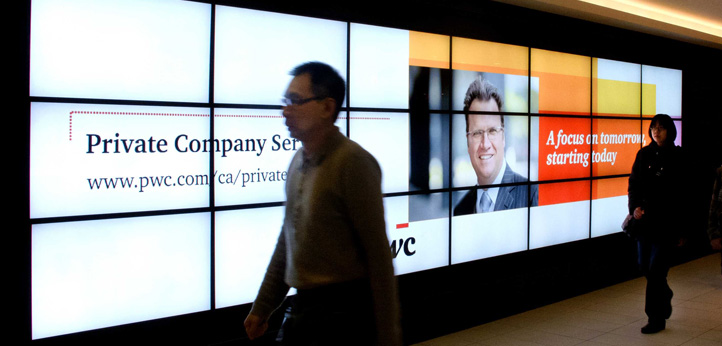Many people are confused about what is the best display technology for Digital Signage. The answer is ‘it depends’. So we thought we would create a few articles on the different types of display technologies commonly used in digital signage deployments. We kick off the series with a look at video walls and their advantages & disadvantages.
What is a video wall?
A video wall is as it’s name suggests a large screen area generally made up of multiple discrete screens tiled together to make one large virtual screen.
 Advantages
Advantages
- Size – Because you can tile as many (within reason) discrete displays as you wish you can create virtual screens that are extremely large. Generally the screens are connected up to a video wall controller box which makes connecting to them almost as simple as connecting a normal screen to a PC.
- Aspect Ratio – You are not constrained to the traditional 4:3 or 16:9 aspect ratios, and if you have a peculiar shaped wall, even shapes like a T shape can be accommodated with a video wall.
- Impact – The larger the screen the greater the notice-ability or impact of the screen.
- Flexibility – Video walls can be constructed from CRT displays, plasma, LCD, Rear Projection. Although it is highly recommended to stick with one technology type (and even the same manufacturer) so that the virtual screen looks consistent across it’s surface.
- Resolution – Obviously is you construct a video wall out of 1080p screens then the overall resolution of the video wall may be massive, meaning a fantastic display resolution.
Disadvantages
- Uniformity – It can sometimes be hard to guarantee colour, brightness, and contrast uniformity between screens, and the human eye is good at spotting differences. Modern screens have settings to adjust these parameters of course, but it can be a time consuming procedure to match screens perfectly. Also when you replace a screen a few years old with a new one it can be even harder.
- Bezels – The vast majority of screens have a bezel or mullion meaning that when you place two side by side then there is an area that cannot display content. Some screens have thicker bezels than others so consideration should be given at planning time which screens to use to minimise this. Also the fact that the bezels may interfere with content., especially text means you may have to produce content creation guidelines to make people aware of this.
- Weight – Structural consideration may be needed as many screens means a lot of weight. Also power & heat needs to be considered.
- Brightness – Depending on the environment one may need to consider if the screens can cope with the ambient light present at the installation location. Simply put if one of the screens looks washed out in the ambient light then they all will. Size does not replace brightness (or contrast for that matter)
- Resolution – This is a double edged sword. At first blush it may seem that having a screen with a resolution of say 15,360 pixels x 8,640 will produce a screen with a fantastic resolution, and indeed it will. But what about the horsepower of the PC that will drive it? and what about content, do you have content of that resolution already, or a content budget to create some?
So this was just a quick look at Video walls and their pros & cons. Next time we will take a quick look at projection technology.

